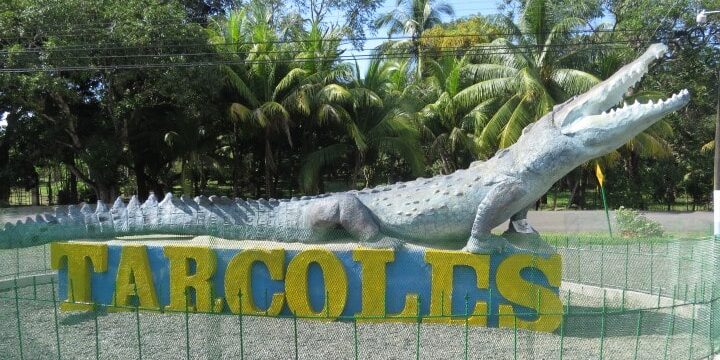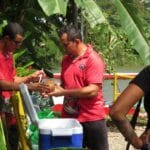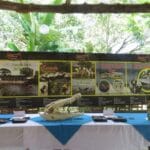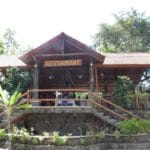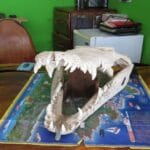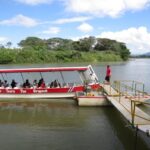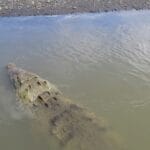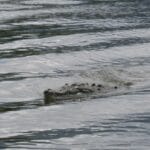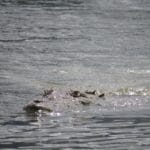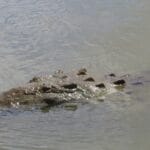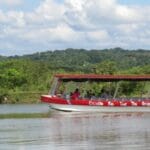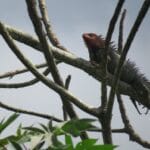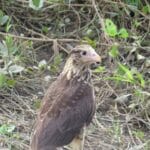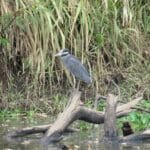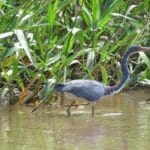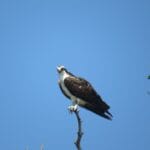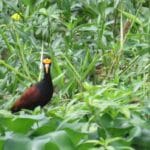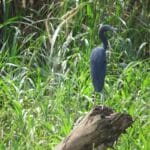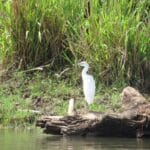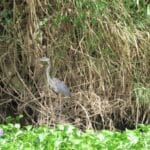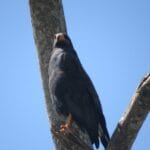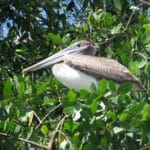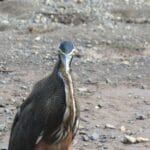We prepare for a day trip on the Tárcoles River. It originates on the southern slopes of the central volcanic mountain range, crosses the central part of the country, and flows southwest (Gulf of Nicoya) into the Pacific Ocean.
This river provides a crucial habitat for many animals and birds, including mammals such as white-faced monkeys and raccoons, as well as reptiles such as crocodiles and iguanas. The Tárcoles River not only irrigates the area’s fields and plantations, but its currents also generate electricity. Many people limit themselves to observing the crocodiles that can be seen from the Tárcoles Bridge, which is used as a transit point. The truth is that the site has great potential for visitors to take the time to explore specifically with the Tárcoles river boat tour. In addition to birdwatching, a boat tour provides access to the largest crocodile population in Costa Rica up close. The river is home to approximately 60% of the country’s crocodiles.
- Welcome Drinks
- Stall
- Restaurant
- Skull
- Reception
- Dock
Crocodile Man Tours not only operates crocodile and birdwatching tours but also offers horseback riding tours on the beach, a visit to Carara National Park, sport fishing, and artisanal fishing, among others.
The offices of the Crocodile Man Tour The Original is located in the center of the small town of Tárcoles, relatively close to Carara National Park and Jacó. A restaurant and a souvenir shop are located just a few meters away, on the way to the dock.
Upon arrival at the dock, the crew serves coconut water “agua de pipa” (a type of drink) to everyone who wants to refresh themselves before boarding the boat and “setting sail” on the current of this important river, into which other rivers, such as the Virilla River and the Río Grande de San Ramón, flow. As many of the Central Valley’s rivers flow into the river, pollution increases downstream, and much of it ends up in the ocean.
Crocodiles
Many Costa Ricans believe that the Tárcoles River is nothing more than a polluted river teeming with crocodiles. The truth is, this river is a privileged spot that allows you to admire a huge number of dinosaurs living in their natural habitat. They are very dangerous animals, and when they are in their natural environment, they look impressive when they are next to the boat. They are their predators, and when they are young, they are ideal prey for males, given their territorial nature. Another of their predators in Costa Rica is the jaguar.
The Tárcoles River has been the subject of numerous studies on the American Crocodile, the only crocodile species that inhabit it. The river is one of the most accessible places in the world to study this magnificent species.
Before strict control over activities on the river existed, some reckless actions were carried out, such as feeding the crocodiles from boats or from the shore to attract the attention of tourists. For this reason, many crocodiles have lost their fear of boats and approach them in search of food. There are now laws prohibiting feeding the animals and engaging in activities such as high-risk fishing. Because there are so many crocodiles, people hunted them to avoid danger. Awareness is growing in different parts of the country, and the Tárcoles River is no exception. The emergence of new laws strengthens the safety of society and, at the same time, of all the species in the river and its ecosystem.
Birdwatching
- Yellow-Headed Caracara (Immature)
- Yellow-Crowned Night Heron
- Tricolored Heron
- Osprey
- Northern Jacana
- Little Blue Heron
- Little Blue Heron (Immature)
- Great Blue Heron
- Common Black Hawk
- Brown Pelican
- Black-Necked Stilt
- Bare-Throated Tiger Heron
The Tárcoles River is, without a doubt, one of the ideal places for birdwatching and identification in Costa Rica. National and migratory species can be observed throughout the year. Some birds migrate from the north, mate, and remain near the river, taking advantage of the favorable climate. Some of these migratory species return north to live out the rest of their lives, while others choose to stay in Costa Rica.
I was ready to see many crocodiles, but I never imagined seeing so many bird species; I had longed to see some in the wild for a long time. After photographing dozens of birds, I was satisfied but about to be even more amazed to see the mangrove trees completely covered in different birds. On each branch lay herons, pelicans, and countless numbers of species that increase in the forested areas of the banks as we traveled through the different sectors of the river, including the crocodile nesting area, the river mouth, the mangrove swamp, and the junction with the brackish ocean water.
The Crocodile Monument
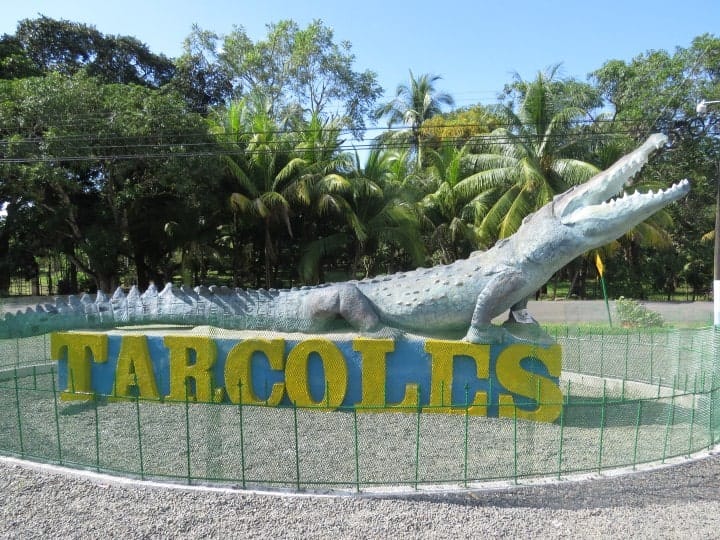
There was a great initiative by the entire Tárcoles community to build a monument at the entrance to the town. The crocodile monument in Tárcoles took approximately four months to build and measures 10 meters long, making it the largest crocodile sculpture in the country. It was built by national artist and sculptor Fabio Brenes Morales, with 36 years of experience and monumental works constructed throughout the country and internationally in countries such as Germany, France, Spain, and Mexico, among others. This renowned artist received assistance from his son (also a sculptor), Sebastián Brenes Fonseca. Fabio Brenes acknowledges that his son is a great sculptor and was instrumental in shaping some parts of the sculpture.
Funding for the crocodile, materials, and labor is provided by the community, including local operators. Some of the contributors include the Municipality of Garabito, Ferreterías el Pacífico, Crocodile Man Tours, and Hotel Villa Lapas, among others.
The artwork deserves great merit. Tárcoles is a predominantly fishing village, and such initiatives greatly contribute to the area’s tourism potential. The entire community of Tárcoles can be proud to have this grand monument at the entrance to their town.
About the River Pollution
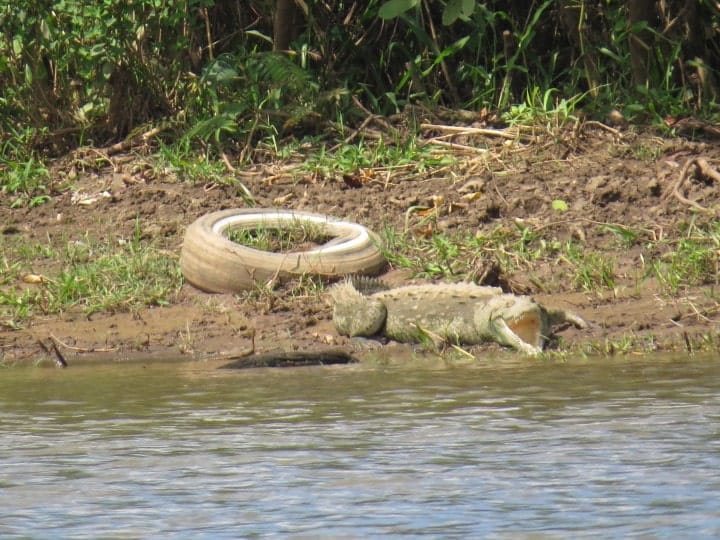
The Tárcoles River is one of the most polluted rivers in the country. However, both the government and the local community of the town of Tárcoles, as well as volunteers, are working hard on programs to clean the river. Much of the pollution in the river dates back 15 or 20 years, causing it to mix with sediment on the banks and in the depths of the river.
It is shocking to realize how polluted we have become. You can see all kinds of trash on the banks mixed with sediment, with plastic bottles and aluminum cans floating in some areas. It is essential to contribute by properly separating waste and recycling the most harmful materials from our homes. The materials that make up many of the products we consume and discard quickly end up in this river.
We must be aware of and take care of our environment, as well as our natural resources. For the sake of all living beings, including our families and loved ones, as well as the plants in this world that ensure our well-being and provide us with many opportunities. For instance, the opportunity to live a happy life and care for others, to be aware of our impact on the world, and to contribute, if possible, to raising awareness among others.
If you want to reproduce this original article, please use the following reference:
Photos and writing by Juan Pablo Soto Sáenz for Giotours | Tárcoles River Boat Tour with Crocodile Man Tours Posted on 29/05/2025. | Link: https://www.giotours.com/tarcoles-river-boat-tour-with-crocodile-man-tours/

